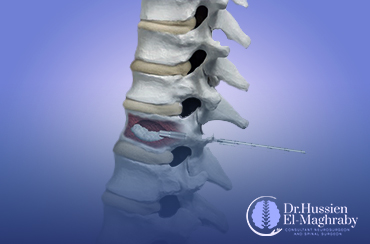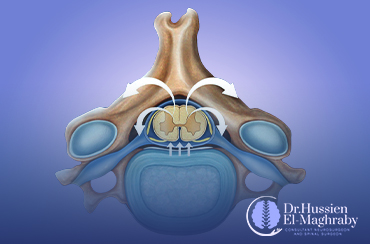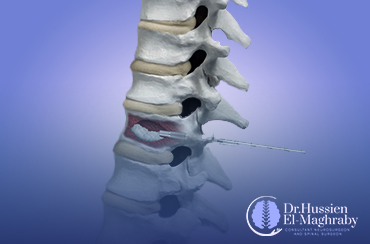
Vertebral Cement Injection
Vertebral cement injection is a procedure used to treat spinal fractures, aiming to relieve pain, which is often caused by osteoporosis or a tumor in the spine. When a vertebra breaks, bone fragments are formed. Pain occurs when these fragments shift, rub against each other, or protrude into the spinal cord. Medical cement is used in vertebral injections to stabilize the bones with a cement mixture, helping to fuse the parts, strengthen the vertebrae, and alleviate pain.
How does vertebral cement injection treat fractures?
Cement injection treats bone fractures in the vertebrae, where the body collapses inward (more in the front than the back), resulting in a wedge-shaped vertebra. This may occur due to:• Osteoporosis (calcium deficiency in bones).
• Spinal injury.
• Metastatic tumors (cancer spreading from another area).
• Bone marrow cancer.
• Vertebral hemangioma.
• Lifting heavy objects, sneezing, or coughing may also cause fractures.
Spinal fractures can lead to back pain, decreased physical activity, depression, loss of independence due to the continued need for assistance, reduced lung capacity, and difficulty sleeping.
Who is the ideal candidate for vertebral cement injection?
You may be a candidate for vertebral cement injection if you are experiencing severe pain due to a compression fracture that has lasted for at least two months and does not improve with other forms of treatment, such as rest, medications, and physical therapy.How should you prepare for vertebral cement injection?
Dr. Hussien El-Maghraby; Consultant Neurosurgeon and Spinal Surgeon at University Hospitals Coventry and Warwickshire NHS Trust, England, United Kingdom, will conduct a physical examination to review symptoms and results of several tests, which may include:• X-rays of the spine.
• MRI or CT scans.
• DEXA bone density test.
• Blood tests.
During this visit, you will schedule the procedure. Waiting too long may allow the bones to harden, making the procedure less effective.
Dr. Hussien El-Maghraby will provide specific instructions to follow before the vertebral cement injection, which may include:
• Stopping certain medications, such as blood thinners and non-steroidal anti-inflammatory drugs, seven days before surgery.
• Taking prescribed medications before the surgery date.
• Not eating or drinking anything for a few hours before the procedure, though sips of water may be allowed to take medications on the day of the procedure.
• Stopping smoking to avoid bleeding and healing issues.
What happens during vertebral cement injection?
• On the day of the procedure, you will lie on your stomach, and the anesthesiologist will apply anesthesia to ensure you do not feel severe or sharp pain during the vertebral cement injection.• Once the anesthesia takes effect, Dr. Hussien El-Maghraby will insert a hollow needle through the skin of your back into the fractured vertebra using a type of X-ray called fluoroscopy to guide the needle to the correct position in the bone. The fluoroscope allows the surgeon to see exactly where the needles are placed and how deep they are inserted throughout the procedure from all angles. The needle is inserted at an angle to avoid the spinal cord.
• Through the needle, Dr. Hussien El-Maghraby injects surgical cement (called polymethyl methacrylate) into the affected area of the bone. The bone cement is injected slowly under pressure, filling the deepest area first, then withdrawing the needle slightly to fill the upper areas. The pressure and amount of cement injected are closely monitored to prevent leakage into unwanted areas. The needles are then immediately pulled out before the cement hardens. This procedure is repeated for each fractured vertebra.
• The vertebral cement injection procedure takes about half an hour for each bone being treated.
What happens after vertebral cement injection?
Once the surgeon completes the procedure, he will remove the needle and apply a bandage for a few days. Your blood pressure, heart rate, and breathing will be monitored, and pain will be managed. You will remain lying down for one hour after the procedure. After one hour, you can sit up. After two hours, you can get up and walk. Most patients stay in the hospital for 24 hours for observation.Follow Dr. Hussien El-Maghraby's instructions for two weeks after surgery or until your follow-up appointment, including:
• Get up and walk 5-10 minutes every 3-4 hours. Gradually increase your walking as tolerated.
• Avoid bending or twisting your back.
• Avoid lifting heavy objects.
• Do not engage in strenuous activities, household chores, or intimate relations.
• Do not drive for the first three days or while taking pain medications or muscle relaxants.
What are the benefits of medical cement injection for vertebrae?
The benefits of medical cement injection for treating osteoporosis and spinal fractures include:• Reduction or elimination of pain, with many patients experiencing significant improvement almost immediately or within a few days.
• Prevention of worsening kyphosis (curved posture) as the cement-reinforced vertebra allows for straighter standing.
• Hospital stay does not exceed 24 hours.
• A recovery period of two weeks is short compared to major surgeries.
• Restoration of mobility, allowing the patient to become more active, which helps combat osteoporosis and prevent further fractures. Increased activity also builds muscle strength, encouraging further movement.
• Improved functional capacity, allowing the patient to return to the previous level of activity without the need for physical therapy sessions.
How successful is vertebral cement injection?
The earlier a fracture is repaired, the better the results. Vertebral cement injection alleviates pain in 75-90% of patients.What are the side effects of vertebral cement injection?
Complications from cement injections are rare with the expertise of Dr. Hussien El-Maghraby, but they can generally include:• Bleeding or infection.
• Blood clots.
• Allergic reactions.
• Nerve damage.
• Movement or migration of the cement outside the fractured bone.
What is the recovery time for vertebral cement injection?
The recovery time for vertebral cement injection is short. You will need to rest for 24 hours after the procedure before returning to your usual routine. Avoid strenuous activities for six weeks following the injection.You may notice pain relief and increased mobility within 48 hours, as most individuals experience immediate pain relief after the procedure. You might feel localized pain from the procedure, but this should subside within three days. Ice can help alleviate any discomfort.
What is the difference between vertebral cement injection and balloon kyphoplasty?
Both vertebral cement injection and balloon kyphoplasty are procedures to treat compression fractures in the spine. During balloon kyphoplasty, the surgeon uses a small balloon to create space for the cement to fill the fracture. The balloon is not part of the vertebral cement injection but is a preliminary step where the surgeon injects the same cement to repair the fracture during this procedure.What happens if fractured vertebrae are left untreated?
If fractured or weakened vertebrae are left untreated, they may lead to a curvature of the spine, resulting in a hunched posture. By restoring the height of the vertebra using medical cement injections into the fractured bone, patients can recover more quickly and reduce the risk of future fractures. Therefore, we recommend consulting the leading expert in minimally invasive neurosurgery and spinal surgery, Dr. Hussien El-Maghraby; Consultant Neurosurgeon and Spinal Surgeon at University Hospitals Coventry and Warwickshire NHS Trust, England, United Kingdom.شارك:
خدماتنا

توسيع القناة العصبية بتقنية (3D Print) والذكاء الاصطناعي
يتم توسيع القناة العصبية القطنية والعنقية وتركيب المسامير والشرائح باستخدام الذكاء الاصطناعي AI والطبع بالبعد الثلاثي 3D Print.

تبخير الغضروف بالليزر بدون جراحة
علاج الانزلاق الغضروفي القطني والعنقي في دقائق، بالتدخل الجراحي المحدود بالليزر، لتبخير الغضروف الضاغط على العصب بدون ألم.

الحقن الأسمنتي للفقرات
يتم علاج هشاشة العظام وكسور العمود الفقري بالتدخل الجراحي المحدود وحقن الأسمنت الطبي.

